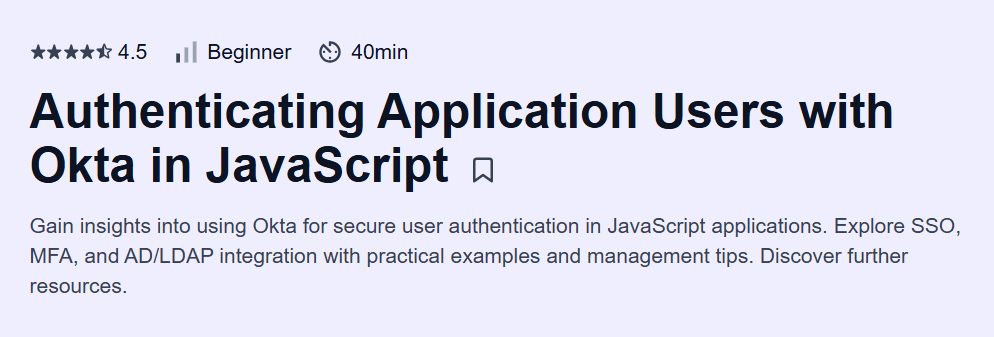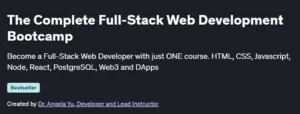What will you learn in Authenticating Application Users with Okta in JavaScript Course
Understand core authentication concepts: OAuth 2.0, OpenID Connect, JWTs
Integrate Okta’s SDKs into JavaScript apps (Node.js backends and React front-ends)
Implement secure user sign-up, sign-in, password recovery, and multi-factor authentication
Configure Okta authorizations: roles, scopes, and policies
Manage user profiles and sessions, handle tokens safely, and comply with best practices
Program Overview
Module 1: Authentication Fundamentals
⏳ 1 week
Topics: OAuth 2.0 flows, OpenID Connect, JSON Web Tokens, security considerations
Hands-on: Diagram and simulate the authorization code flow with PKCE
Module 2: Okta Setup & Configuration
⏳ 1 week
Topics: Okta Developer Console, applications vs. APIs, client credentials, redirect URIs
Hands-on: Create an Okta org, configure a JavaScript SPA application, and register scopes
Module 3: Front-End Integration (React)
⏳ 1 week
Topics:
@okta/okta-auth-jsand@okta/okta-reactpackages, secure routing, token storageHands-on: Build a React app with protected routes, user profile display, and logout
Module 4: Back-End Integration (Node.js)
⏳ 1 week
Topics: Verifying and decoding JWTs, middleware setup, role-based access control
Hands-on: Implement Express middleware to protect API endpoints and enforce scopes
Module 5: Advanced Features
⏳ 1 week
Topics: Multi-Factor Authentication (MFA), social login, custom sign-in widgets, session management
Hands-on: Enable MFA in your Okta org and integrate Google social login
Module 6: Token Lifecycle & Security Best Practices
⏳ 1 week
Topics: Refresh tokens, token revocation, secure cookie vs. local storage, CORS considerations
Hands-on: Implement silent token renewal and safe storage strategies
Module 7: User Management & APIs
⏳ 1 week
Topics: Okta Management API usage for users/groups, automations, and event hooks
Hands-on: Write scripts to bulk-import users and assign group memberships via the API
Module 8: Capstone Project
⏳ 1 week
Topics: End-to-end authentication flow, error handling, logging, and deployment
Hands-on: Build and deploy a full-stack JavaScript app (React + Node) secured by Okta
Get certificate
Job Outlook
Authentication and identity management skills are essential for full-stack and security-focused roles
Roles include Front-End/Back-End Engineer, Security Engineer, and Identity & Access Management (IAM) Specialist
Salaries range from $90,000 to $150,000+ depending on specialization and region
Experience with Okta and modern auth flows boosts employability in SaaS, fintech, healthcare, and enterprise IT
Specification: Authenticating Application Users with Okta in JavaScript
|
FAQs
- Basic JavaScript knowledge is essential, but prior authentication experience isn’t required.
- Familiarity with web applications and APIs helps but is optional.
- The course explains concepts like login, tokens, and sessions from scratch.
- No previous exposure to OAuth or OpenID Connect is needed.
- Step-by-step examples make it accessible to beginners in authentication.
- Yes, Okta can be integrated into both frontend and backend JavaScript applications.
- The course mainly demonstrates frontend implementation examples.
- Backend integration concepts are explained and can be extended independently.
- Skills gained can be applied to securing APIs and web applications.
- Knowledge is transferable to other frameworks like Node.js and React.
- Basic API security concepts are introduced in the course.
- Focus is on authenticating users before they access protected routes.
- Detailed backend API security may require additional resources or practice.
- Course examples provide a foundation for implementing secure endpoints.
- Learners can expand these concepts to full API security independently.
- Yes, understanding Okta concepts helps in transitioning from other providers.
- The course highlights core principles like tokens, sessions, and user management.
- Provides guidance on integrating Okta-specific SDKs in JavaScript apps.
- Skills learned can be applied to adapt existing authentication flows.
- Helps in comparing different authentication solutions for best practices.
- The course includes step-by-step coding exercises to implement authentication flows.
- Students practice creating login, registration, and logout features.
- Examples cover session handling, tokens, and protected routes.
- Hands-on practice reinforces understanding of Okta SDK and JavaScript integration.
- Additional exercises outside the course are encouraged for mastery.





